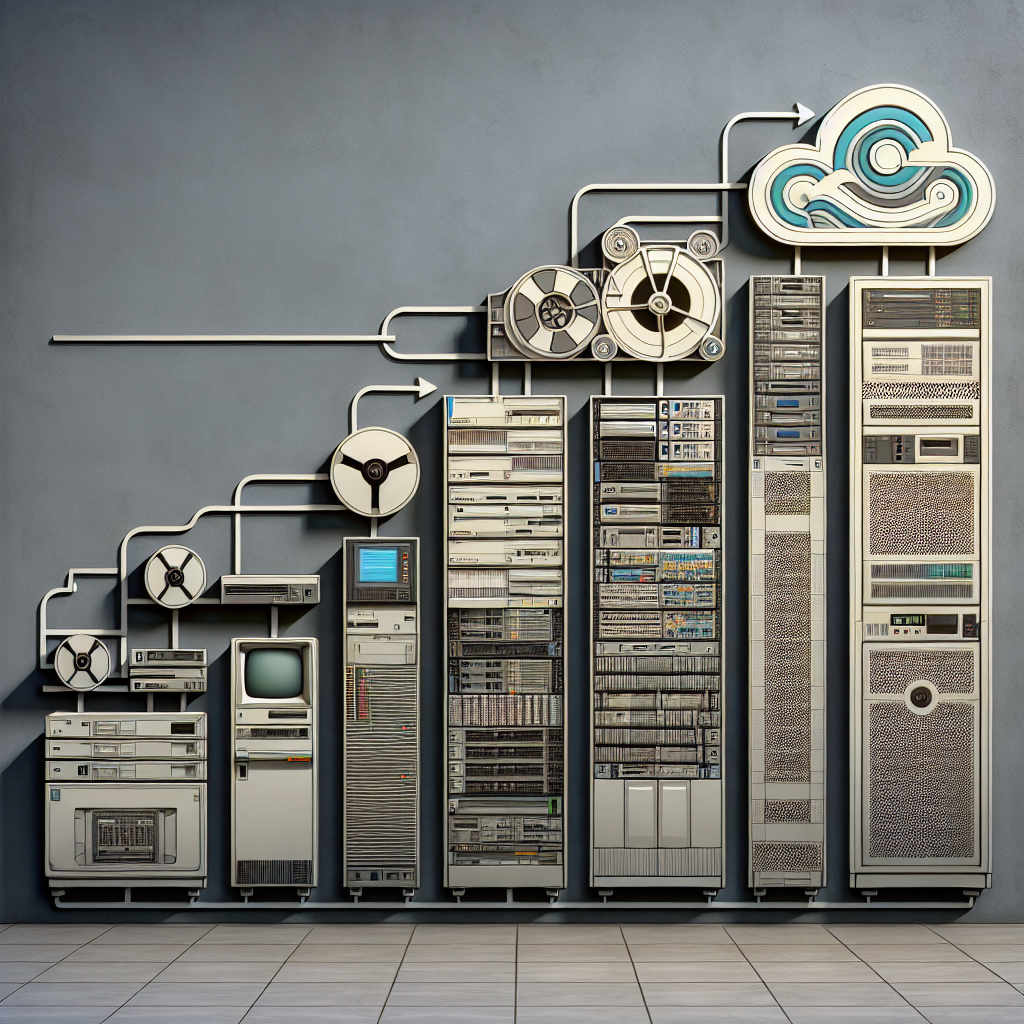Your cart is currently empty!
Tag: Mainframes

The Evolution of Cloud Computing: From Mainframes to the Cloud
Cloud computing has revolutionized the way businesses and individuals store, access, and manage data. But how did we get here? The evolution of cloud computing can be traced back to the early days of computing, when mainframe computers dominated the industry.Mainframes were large, expensive machines that required specialized knowledge to operate. They were typically housed in data centers and accessed by users through terminals. While mainframes were powerful and reliable, they were also costly and difficult to scale.
In the 1970s, the concept of distributed computing emerged, allowing multiple computers to work together on a task. This led to the development of client-server architecture, where a central server provided services to multiple clients. This model allowed for more flexibility and scalability than mainframes, but still required significant investment in hardware and infrastructure.
The next major milestone in the evolution of cloud computing came in the 1990s with the advent of virtualization technology. Virtualization allowed multiple virtual machines to run on a single physical machine, providing greater efficiency and flexibility. This technology laid the foundation for the development of cloud computing as we know it today.
In the early 2000s, companies like Amazon and Google began offering cloud services to the public, allowing users to access computing resources over the internet. This marked the beginning of the era of cloud computing, where users could rent virtual servers and storage on a pay-as-you-go basis.
Today, cloud computing has become ubiquitous, with businesses and individuals relying on cloud services for everything from file storage to software development. The cloud offers numerous benefits, including scalability, cost savings, and increased agility.
As technology continues to evolve, we can expect to see even more advancements in cloud computing. Innovations like edge computing, serverless computing, and hybrid cloud solutions are already changing the way we think about the cloud.
The evolution of cloud computing from mainframes to the cloud has been a long and fascinating journey. As technology continues to advance, the possibilities for cloud computing are endless. Whether you’re a small business owner or a tech enthusiast, the cloud offers a world of opportunities for innovation and growth.

From Mainframes to Cloud Computing: A History of Fujitsu’s Contributions to the IT Industry
From Mainframes to Cloud Computing: A History of Fujitsu’s Contributions to the IT IndustryFujitsu, a leading global IT services provider, has a long and storied history of innovation and technological advancements. From its early days as a manufacturer of mainframe computers to its current position as a major player in the cloud computing industry, Fujitsu has consistently pushed the boundaries of what is possible in the world of information technology.
Founded in 1935 as a telecommunications equipment company, Fujitsu quickly expanded into the computer market in the 1950s and 1960s. The company’s mainframe computers were among the most advanced of their time, offering unparalleled processing power and capabilities. Fujitsu’s mainframes became a staple in businesses and government agencies around the world, helping to revolutionize the way data was processed and stored.
In the 1980s and 1990s, Fujitsu continued to innovate, developing new technologies and products that further solidified its reputation as an industry leader. The company played a key role in the development of the UNIX operating system, which became a standard in the IT industry. Fujitsu also introduced the world’s first 300-megabit-per-second fiber-optic network, paving the way for high-speed internet connections.
As the internet became more prevalent in the early 2000s, Fujitsu shifted its focus to cloud computing, recognizing the potential for this technology to revolutionize the way businesses store and access data. The company invested heavily in developing cloud-based solutions, offering a range of services that allowed businesses to scale their IT infrastructure as needed without the need for costly hardware upgrades.
Today, Fujitsu is a major player in the cloud computing industry, providing a wide range of services to businesses of all sizes. The company’s cloud offerings include infrastructure as a service, platform as a service, and software as a service, giving businesses the flexibility and scalability they need to stay competitive in today’s fast-paced digital world.
In addition to its work in cloud computing, Fujitsu continues to innovate in other areas of the IT industry. The company is a leader in the development of artificial intelligence and machine learning technologies, helping businesses harness the power of data to drive innovation and growth.
Overall, Fujitsu’s contributions to the IT industry have been significant and far-reaching. From its early days as a manufacturer of mainframe computers to its current position as a major player in the cloud computing industry, Fujitsu has consistently pushed the boundaries of what is possible in the world of information technology. With a legacy of innovation and a commitment to excellence, Fujitsu is poised to continue shaping the future of the IT industry for years to come.

From Mainframes to Wearables: A Look at Fujitsu’s Diverse Range of Products
Fujitsu is a global leader in the technology industry, known for its diverse range of products that cater to various needs and preferences of consumers. From mainframes to wearables, Fujitsu has continuously evolved and adapted to the changing landscape of technology, staying ahead of the curve with innovative solutions that enhance productivity and improve user experiences.One of Fujitsu’s most notable products is its mainframe computers, which have been a staple in the industry for decades. Mainframes are large, powerful computers that are used by organizations to process and store massive amounts of data. Fujitsu’s mainframes are known for their reliability, security, and scalability, making them a popular choice for businesses that require high-performance computing solutions.
In addition to mainframes, Fujitsu also offers a wide range of servers, storage solutions, and networking products that cater to the needs of businesses of all sizes. These products are designed to deliver high performance, reliability, and efficiency, helping organizations streamline their operations and achieve their business goals.
Fujitsu has also expanded its product portfolio to include consumer electronics, such as laptops, tablets, and smartphones. These devices are designed to meet the needs of modern consumers who are looking for powerful, portable, and user-friendly devices that enhance their productivity and connectivity.
One of Fujitsu’s most recent innovations is its line of wearables, which includes smartwatches, fitness trackers, and augmented reality glasses. These devices are designed to help users stay connected, track their health and fitness goals, and access information in a hands-free manner. Fujitsu’s wearables are known for their sleek design, advanced features, and seamless integration with other devices, making them a popular choice for tech-savvy consumers.
Overall, Fujitsu’s diverse range of products reflects the company’s commitment to innovation, quality, and customer satisfaction. Whether you’re a business looking for high-performance computing solutions or a consumer in search of cutting-edge electronics, Fujitsu has a product that meets your needs. With its dedication to staying ahead of the curve and delivering products that enhance the way we work and live, Fujitsu is poised to continue leading the technology industry for years to come.

The Evolution of Data Center Servers: From Mainframes to Virtualization
Data centers have undergone significant changes over the years, especially when it comes to the servers that power them. From the early days of mainframes to the rise of virtualization, the evolution of data center servers has been nothing short of remarkable.Mainframes, which first emerged in the 1950s, were the original backbone of data centers. These large, powerful machines were capable of processing vast amounts of data and running multiple applications simultaneously. Mainframes were the go-to option for organizations that needed high levels of reliability and security.
However, as technology advanced and the demands on data centers grew, mainframes began to show their limitations. They were expensive to purchase and maintain, and their proprietary hardware and software made them inflexible and difficult to scale. This led to the emergence of smaller, more flexible servers known as rack-mounted servers.
Rack-mounted servers revolutionized the data center industry by allowing organizations to scale their infrastructure more easily and cost-effectively. These servers were housed in standardized racks, making it easier to manage and upgrade them. They also allowed for greater customization and flexibility, as organizations could mix and match different types of servers to meet their specific needs.
The next major breakthrough in data center servers came with the advent of virtualization technology. Virtualization allowed organizations to run multiple virtual servers on a single physical server, maximizing the use of hardware resources and reducing costs. This technology also made it easier to manage and allocate resources, leading to greater efficiency and flexibility in data center operations.
Today, virtualization is a standard practice in data centers around the world. Organizations can create virtual servers on-demand, scale their infrastructure quickly, and easily move workloads between physical servers. This has paved the way for cloud computing, where organizations can access computing resources over the internet without the need to invest in physical servers.
Looking ahead, the evolution of data center servers is likely to continue as new technologies such as containerization and edge computing gain traction. These technologies promise to further enhance the efficiency, flexibility, and scalability of data center operations, ensuring that organizations can meet the ever-increasing demands of the digital age.
In conclusion, the evolution of data center servers from mainframes to virtualization has been a game-changer for organizations looking to maximize their IT infrastructure. As technology continues to advance, data centers will continue to evolve, providing even greater capabilities and opportunities for innovation.

From Mainframes to Cloud Computing: The Changing Face of Fujitsu
Fujitsu, a global leader in IT services and solutions, has come a long way since its early days as a manufacturer of mainframe computers. As technology has evolved over the years, so too has Fujitsu, adapting to the changing landscape of the IT industry.In the early days of computing, mainframes were the dominant form of computing power, with large, centralized machines handling the processing needs of businesses and organizations. Fujitsu was at the forefront of this technology, developing advanced mainframes that helped to revolutionize the way that data was stored and processed.
However, as technology continued to advance, the landscape of computing began to change. The rise of personal computers and the internet led to a shift away from mainframes towards more distributed computing models. This shift presented a challenge for Fujitsu, as the company had to adapt its business model to stay relevant in the rapidly changing IT industry.
One of the key ways that Fujitsu has adapted to this changing landscape is through the development of cloud computing services. Cloud computing allows businesses to access computing resources over the internet, rather than having to invest in expensive hardware and software. Fujitsu has been at the forefront of this technology, offering a range of cloud computing services to help businesses streamline their IT operations and reduce costs.
In addition to cloud computing, Fujitsu has also expanded its offerings to include a wide range of IT services and solutions, including cybersecurity, data analytics, and artificial intelligence. By diversifying its portfolio, Fujitsu has been able to stay ahead of the curve and continue to provide cutting-edge technology solutions to its customers.
Overall, the changing face of Fujitsu reflects the broader evolution of the IT industry. By embracing new technologies and adapting to changing trends, Fujitsu has been able to maintain its position as a global leader in IT services and solutions. As the company continues to innovate and grow, it is sure to remain a key player in the ever-changing world of technology.

Exploring the Evolution of Data Centers: From Mainframes to Cloud Computing
Data centers have come a long way since their inception in the 1960s with the introduction of mainframe computers. These large, room-sized machines were the backbone of early computing, handling all the data processing and storage needs of businesses and organizations. However, as technology advanced and the demand for more efficient and scalable computing solutions grew, data centers evolved to keep up with the changing times.One of the major developments in data center evolution was the shift from mainframes to client-server architecture in the 1980s. This decentralized approach allowed for greater flexibility and scalability, as well as improved reliability and performance. With the rise of the internet and the proliferation of personal computers, data centers became more distributed and interconnected, leading to the emergence of colocation facilities and hosting providers.
The next major milestone in data center evolution was the advent of virtualization technology in the early 2000s. This allowed for the consolidation of multiple servers onto a single physical machine, leading to increased efficiency, cost savings, and easier management of resources. Virtualization also paved the way for cloud computing, a paradigm shift that revolutionized the way data centers were designed and operated.
Cloud computing allows for on-demand access to a shared pool of resources, such as storage, processing power, and applications, over the internet. This model has democratized access to computing resources, making it easier for businesses of all sizes to leverage the power of data centers without investing in expensive hardware and infrastructure. Cloud computing has also led to the rise of hyperscale data centers, massive facilities that can support the needs of global internet giants like Amazon, Google, and Microsoft.
With the increasing demand for data storage and processing power driven by trends like big data, artificial intelligence, and the Internet of Things, data centers continue to evolve to meet the needs of the digital age. Technologies like edge computing, which brings processing power closer to the source of data, and renewable energy solutions, which aim to reduce the environmental impact of data centers, are shaping the future of this vital industry.
In conclusion, the evolution of data centers from mainframes to cloud computing has been a testament to the ingenuity and innovation of the technology industry. As we continue to push the boundaries of what is possible with data and computing, data centers will play a crucial role in enabling the digital transformation of businesses and society as a whole. It will be fascinating to see how data centers continue to evolve in the years to come.

The Evolution of Data Center Servers: From Mainframes to Cloud Computing
Data centers are the backbone of today’s digital world, housing the servers and networking equipment that enable businesses to store, process, and distribute vast amounts of data. Over the years, data center servers have evolved significantly, from the early days of mainframes to the rise of cloud computing.Mainframes were the first type of data center servers and were used primarily in the 1960s and 1970s. These massive machines were housed in large rooms and required specialized cooling and power systems to operate. Mainframes were designed to handle a wide range of computing tasks, from processing transactions to running complex calculations. However, they were expensive to purchase and maintain, making them out of reach for all but the largest organizations.
In the 1980s and 1990s, the rise of client-server computing led to a shift away from mainframes towards smaller, more affordable servers. These servers were less powerful than mainframes but could be easily scaled to meet the needs of growing businesses. They also offered greater flexibility and allowed for the development of new applications and services.
The advent of the internet in the late 1990s brought about a new era in data center servers with the rise of cloud computing. Cloud computing allows businesses to access computing resources on-demand over the internet, without the need to invest in and manage their own servers. This has led to a significant reduction in costs and increased agility for businesses of all sizes.
Today, data center servers are more powerful and efficient than ever before, thanks to advancements in technology such as virtualization and containerization. Virtualization allows multiple virtual servers to run on a single physical server, maximizing resource utilization and reducing costs. Containerization, on the other hand, allows applications to be packaged and deployed independently of the underlying infrastructure, making it easier to scale and manage applications in a cloud environment.
The evolution of data center servers has transformed the way businesses operate, enabling them to store and process vast amounts of data with greater efficiency and flexibility. As technology continues to advance, we can expect data center servers to become even more powerful and cost-effective, driving further innovation and growth in the digital economy.
